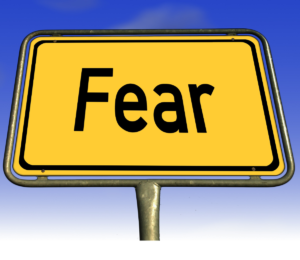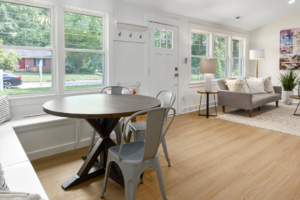Who wants to successfully declutter?
Clothes. Books. Craft supplies. Letters. Magazines. Cards. Cherished collection.
How difficult is it for you to delete (permanently remove) items that no longer serve an active purpose in your life?
Over the years, I’ve heard many reasons (excuses?) why it’s difficult to cull stuff:
- Clothes.”I’ll fit in it once I lose a little weight” or “That brings back memories.”
- Collectibles. “It’s valuable!” or “I’ve had them for years.”
I could give more examples, however I think you get the idea.
What do these responses have in common?

And what does FEAR stand for? A number of things:
Finding Excuses and Reasons. “I don’t have the time to declutter.” There will almost always be something you’d rather do than declutter. “I can’t delete that because….” You can always create a “reason” why you can’t delete an item.
Feel Emotion and Run. Any trip down memory lane is filled with emotions. When we sort through multiple items that all yield strong feelings, a common response is “This is too hard, I’m out of here!”
Future Events Appearing Real. “I might need it someday.” It’s possible. It’s also entirely possible that you won’t need it in the future. You could probably make a case for anything being useful in the future. However, that would mean keeping everything. Are you ready to keep that amount of stuff?
Forget Everything and Run. “I’m overwhelmed and don’t know where to start!” While postponing until you “feel” ready may seem like a good idea, it just gives additional time for the uncertainty and overwhelm to grow larger.
False Expectations Appearing Real. You might keep items because you want to be able to supply anything that someone might request. While hearing their “thanks” warms your heart, is it worth having extra stuff?
You may be thinking, “Wow! Janice really understands!” And I do. I can struggle with the same thoughts when I’m trying to cull my possessions. However, getting stuck in these FEARs means living a life full of possessions, possibly at the expense of other parts of your life.
In her book Feel the Fear…and Do It Anyway, author Susan Jeffers, Ph.D. puts forth that fear is primarily an educational problem rather than a psychological one. She believes “that by reeducating the mind, you can accept fear as simply a fact of life rather than a barrier to success.” Interesting idea, right?
I highly recommend this book because, from personal experience, I know that in various facets of life, it will empower you now and for years to come.
Keeping this in mind, let’s see how the following concepts decrease the fear associated with decluttering:
FACE EVERYTHING AND RISE. Whether it’s decluttering or another task you don’t want to do, ignoring or postponing it doesn’t make it go away. In fact, it usually intensifies the dread.
Instead, acknowledge the fear and focus on the positive impact.
- “I know deleting items is difficult, however it’ll feel like a weight has been lifted once I’m able to find items when I need them.“
- “I’m tired of feeling like there’s an elephant taking up all my space, so I need to take steps to decrease the size of the elephant until I can get it out my door.”
- “Once I start decluttering, I will feel more comfortable with it. Deleting will become easier.“
FEARLESSLY ENSURE AND RECOVER. In conjunction with Face Everything and Rise, you have to Fearlessly Endure and Recover. Yes, you will experience some apprehension or other uncomfortable feelings. It’s completely normal. However, you’ll rally and things will get better!
Decluttering isn’t something you can avoid forever. The only way is through.
FOR EVERYTHING HAS A REASON. You had a rationale for keeping your stuff. You can have reasons to delete your stuff. Here are just a few:
- Usage. Clothes that don’t fit or that you no longer like. Kitchen equipment that requires too much effort to use. Extra furniture.
- Multiples. You keep the best three pairs of jeans out of seven. Only retain two sets of sheets per bed.
- Accuracy. Outdated training manuals and books. Old or incomplete information in magazines.
- Significance. Hobbies that are no longer of interest. You moved and aren’t responsible for lawn care. Activities you don’t participate in anymore.
- Expiration. Food, make-up, medicine, and other items that have expiration dates. Electronics that don’t work.

Cathy (not her real name) lead an active personal and professional life prior to multiple diagnoses impairing her life. Her conditions include, but aren’t limited to, severe ADHD, fibromyalgia, obsessive-compulsive disorder (OCD), and migraines. She’s also impacted by Postural Orthostatic Tachycardia Syndrome (POTS) which includes periods of time when she’s unable to stand due to extreme dizziness. This combination forced her to give up her job, fluctuate greatly in weight, and have limited periods of energy.
Because Cathy sometimes had to use a wheelchair or other mobility aid, “easy access” was more limited since she didn’t know if she’d be able to bend over to reach a low shelf or look up to locate an item on a high shelf. Cathy’s goals included having easy access to clothes as well as her journaling and craft supplies. The problem was she had clothes in many different sizes due to big weight changes which were difficult to control, she was interested in many different types of crafts, and journaling was an important factor for her self-care.
Here are some of the strategies that were implemented to help her create a functional space:
- locate the clothes she wears most often at waist-height in drawers, hangers, bins, etc.
- assemble a small, easy-to-carry bag with the bare minimum journaling supplies
- design a small craft area on the main floor with the items necessary for the craft projects she engaged in the most
- minimize the amount of clothing in the outer ranges of her smallest/largest weight
- designate a location for journal supplies not contained in the portable bag
- establish a hub for all craft supplies not on the main floor
An important aspect to making things ultra accessible was to cull the overall number of items in each category. This was accomplished through deciding on physical boundaries, such as all yoga pants have to be contained within this one drawer.
Cathy really appreciates the easier access to her clothes as well as her ability to journal and craft.
Question: what prevents you from decluttering?
Let me know below.



